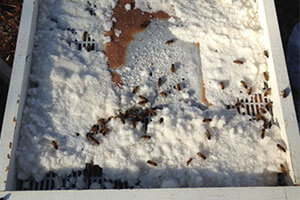
As I write this in February, it is time to feed bees this late winter. I am using feeder boards with fondant this winter. I knew some of the hives were weak. I have lost a few colonies and this winter is not over yet. There are at least two more colonies in trouble. I will be able to split the others this spring if the buildup is good.
I made feeder boards for feeding the bees. The easiest way to make them that I have found is to use 1 x 2 boards and a plastic queen excluder. I ordered the plastic excluders from Dadant as you might expect. The 1 x 2 boards came from the local lumber shed. I buy the primed white ones because they are easy to cut and seem to last longer. They are also light weight. The boards for the frame are cut in pairs; 2 of 16 ¼ & two of 18 5/8 inches then glued and screwed together on the ends. I have a miter saw that cuts the square ends and I do not cut 45 degree angles. I admit the 45s are stronger and more finished. But, using straight boards makes the process faster and easier.
Once the frame is made, the plastic queen excluders can be fastened with 1 inch screws. This helps to strengthen the frame and makes the apparatus ready to go. There is some weight to the sugar fondant. The recipe is 15 parts sugar to one part water. I add one tablespoon of vinegar to help keep out mold and bacteria. Also, I add just a pinch of sea salt. Finally, a bit of honey makes the fondant more palatable. One tablespoon of honey per gallon helps. The sea salt seems to promote uptake and health. The candy is a near solid mixture. The feeder board allows bee access to the sugar through the queen excluder.
It is desirable here in the middle of the country to put these on when the weather gets about 50 degrees and the wind is less than 20 mph. This happens around Christmas or by February here. It would be much later in winter or earlier in fall from St. Louis north or above 500 feet elevation. The feeder board is placed directly over the brood chamber, queen excluder down. It is best to put a patty of pollen substitute in the center. I like to add a bit of real pollen to the pollen substitute as the bees take it better. The fondant is spread around the pollen patty, directly over the bees.
The semisoft candy is not as accessible as sugar syrup, but it has much more sugar than any syrup. The bees will take it. The fondant in large quantities will feed bees for a longer period of time than syrup. Fondant provides a lot more calories per unit of volume than syrup. Having a large quantity of fondant (2 – 4 quarts) above the brood chamber enables bee access, even in cold weather. The fondant is available because it is next to the warm cluster of bees. Think of this feeding system as an insurance policy against starvation. If honey supplies run low, the bees have sugar literally just above them.
With the candy board open to the cluster, most condensation from bee respiration will be absorbed by the fondant above the warm cluster. Wet bees will die in winter. The fondant absorption of condensation prevents rain inside the colony. Warm air can yet escape above the feeder board full of fondant through the hole in the inner cover.
Condensation control is another benefit of feeder boards. The long-term feeding is another advantage. Instead of feeding colonies once a week with a syrup feeder, it is possible to


